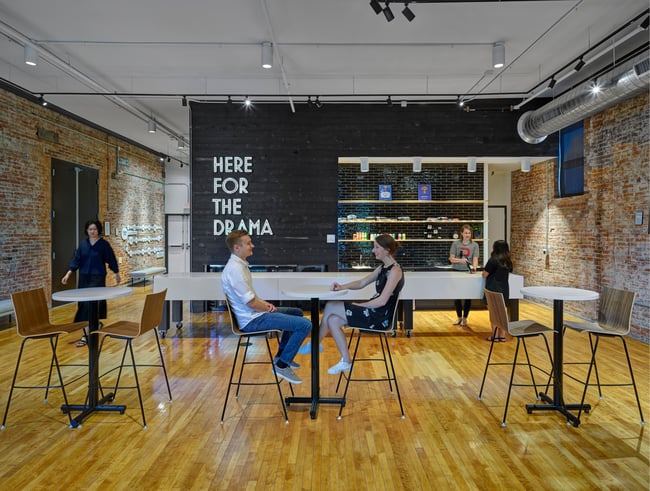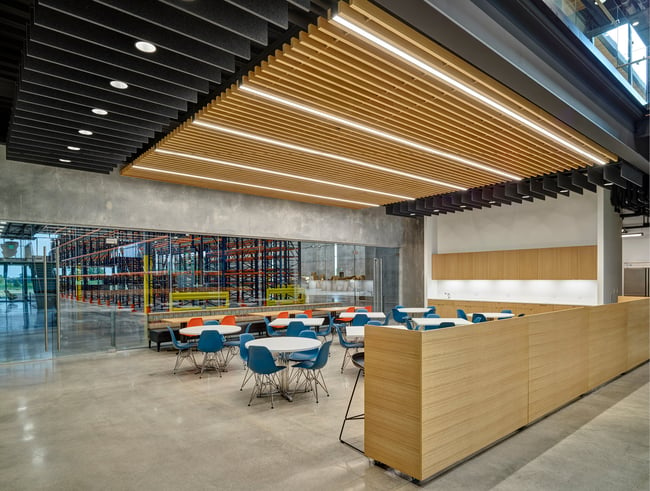Tips for Selecting Furniture on a Commercial Building Project

Furniture selection is one of the most important aspects of a commercial building project. Occupants use furniture daily, and it can impact their well-being, productivity, and satisfaction. It is also a significant investment, requiring careful planning and consideration.
Over the years, we have helped countless commercial owners procure Furniture, Fixtures, and Equipment (FF&E). In our experience, there can be some confusion around the significance of this investment and the best practices when making selections.
This article will discuss a few tips to remember when selecting furniture, helping you prepare for your project.
4 Tips for Furniture Selection
1. Work with an Interior Designer
When selecting furniture, you can go directly through a furniture dealer or work with an interior designer. Working with a dealer can be more convenient if you know what you want—especially on smaller projects. However, on larger and more complex projects, working with an interior designer is the best practice.
An interior designer understands the space’s look, feel, and function and can help you make selections that align with the project’s vision. When working with a dealer, you risk losing the design’s cohesiveness.

An interior designer can help you achieve a cohesive, functional space.
At the same time, an interior designer understands your overall budget and can help you maximize its value. They may recommend investing in furniture that experiences the most wear and tear—like workstations and task chairs—and help you find lower-cost options for infrequently used items.
Unlike a dealer, interior designers are not salespeople. They do not receive commissions for selecting certain products. Instead, their job is to help you make selections that fit your budget and project goals.
Keep in mind: Owners have a separate contract with dealers. However, the interior designer is responsible for making selections and coordinating communication.
2. Plan Furniture Early
On commercial projects, furniture selection can be complex. Researching options and making selections can take months, and lead times vary. Even on a small project, furniture may not arrive on site for weeks or even months.
At the same time, early design decisions should be made with furniture in mind. Furniture provides functionality, and spaces should be designed to accommodate specific items.
If you wait too long to select furniture, you risk designing a building that does not meet the users’ needs. The types of items you envision should be discussed in the early phases of the design process.
3. Use Commercial-Grade Furniture Option
Commercial-grade furniture can be expensive, and it’s tempting to explore residential options to lower the cost. Although costly, commercial-grade options are always a sound investment.
Commercial furniture is rigorously tested by organizations like BIFMA to meet standards for weight, durability, and ergonomics. These products can withstand more use and accommodate more body types than residential options.
Commercial-grade task chairs, for example, provide better adjustability, lumbar support, and durability. In office settings, people spend most of their time in these chairs. Their quality can significantly impact occupants’ productivity and health.

Use commercial-grade products for items like workstations and task chairs.
At the same time, commercial-grade furniture often comes with a warranty. You can get replacement parts and, potentially, new items for years, making it a sound investment.
Your interior designer can help you make the most out of your furniture budget. While you should invest in commercial-grade products in areas that receive the most use, you may be able to select lower-cost residential items in some areas. For example, bookshelves and decorative accessories can be more residential depending on the space and your needs.
4. Standardize Selections
When selecting commercial furniture, it helps to standardize your choices. Setting guidelines and repeating furniture items throughout a facility simplifies the selection process.
It also makes for easier maintenance. When problems arise, you can contact a single vendor for replacement parts.

Standardizing selections makes for easier replacements and repairs.
Vendors may also offer discounts for bulk purchases, depending on the product category. Workstations, for example, may be discounted deeper than lounge pieces. Ideally, large quantity items will come from a single product vendor.
Learn More About Commercial Interior Design
Along with flooring, furniture is one of the most important choices in interior design. It faces plenty of wear and tear and directly impacts occupants’ well-being and satisfaction.
In our experience, furniture is not a decision to take lightly. You should consider occupants’ needs, long-term costs, and maintenance and replacements when making selections. You should also start planning furniture early in the design process, so the completed building meets your functional needs.
An interior designer can help you make selections that fit your budget and project goals. They can also assist with interior layouts, materials and finishes, and other crucial aspects of a building project. Learn more by reading about an interior designer’s role in the design process.